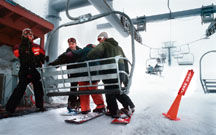No shortage of snow: Shasta Ski Park crews keep busy by bounty
Mail Tribune
Medford, Oregon
March 2, 1998
By BILL KETTLER
Photo by Andy Atkinson
Lift operator Zach Pike loads a trio of snowboarders onto the Coyote chairlift at Mount Shasta Ski Park Sunday afternoon. Workers have had to dig out the rope tows, chair lifts and operators’s shelters more than once this season at Shasta.
This will be a winter they’ll remember for a long time around Mount Shasta.
Storms rolled across Northern California one after another in January and February, burying the Mount Shasta Ski Park in 15 to 20 feet of snow.
“We’ve only had four days without measurable precipitation since Jan. 1,” said Tim Larive, the ski area’s marketing director.
Larive said the mountain had collected more than 20 inches of precipitation (almost all of it as snow) for the month of February, compared to a normal monthly average of about 2 inches.
Workers have shoveled out the ski area’s rope tow at least four times, and a 60-foot mound of snow has accumulated next to the rope tow, Larive said. Shoveling snow away from the shacks that shelter ski lift operators has been an almost daily chore. Crews had to shovel away snow from some chair lifts to provide enough clearance for the lifts to operate.
The private road crew that clears the ski park road has worked nearly nonstop to keep up with the storms. Larive said some people have worked without a day off since Jan. 1, and bulldozers have been brought to the ski area to push accumulated snow off the parking lot.
Larive said the deep snow has given him a rare opportunity to take a break from putting the mountain’s skiing conditions in the best possible light. “This is the first time in my life I’m underestimating our snowpack.”
Most of the big storms brought rain to Southern Oregon, but a storm late last week gave the region a taste of what life has been like around Mount Shasta. Nearly four feet of snow fell on Mount Ashland in two days, leaving ski area employees with plenty of their own shovel work.
“We’ve got Sno-Cats (to remove snow),” said ski area manager Glenn Menzie, “but there’s a lot of places the Sno-Cats can’t get.
“Luckily,” he said, “we have a lot of strong young kids.”
Crews that groom the ski runs had extra work, too, trying to keep up with the snow.
“It’s hard to groom 42 inches of snow,” said Menzie. “You don’t just go up and down once and have it look great.”
The big storm was the first major challenge this winter for the Oregon Department of Transportation crews that maintain Interstate 5 over the Siskiyou Summit.
“We had a few extra 12-hour shifts,” said Zona Erickson, assistant manager for ODOT’s Ashland maintenance station.
Erickson said relatively warm temperatures through much of the wet season brought little snow to Interstate 5 until last week.
“We were expecting about 10 inches,” she said, but 19 inches fell at the measuring station near the maintenance sheds by the Mount Ashland freeway exit at milepost 6.
Erickson said the station’s snow blower went down during the storm, but the crews were able to borrow a similar machine from the Prospect station to keep the road open.
Blowing snow and an equipment failure forced the National Park Service to close the road to the rim of Crater Lake National Park for nearly two weeks before it reopened on Friday.
Road foreman Ron Theall said the park service’s newest snow-blowing machine broke down just as park service road crews struggled to deal with five to 10 feet of new snow.
Theall said the park service had to concentrate on keeping Oregon Highway 62 open through the park and let the snow accumulate on the steep road to the rim.
“We had to go to 12-hour shifts and 24-hour days to try to keep it open.”
Other pages in this section


